
Zhang Sanfeng refers to a legendary Chinese Taoist who many believe invented the Chinese martial art tai chi. However, other sources point to earlier versions of tai chi predating Sanfeng. He was purported to have achieved immortality.
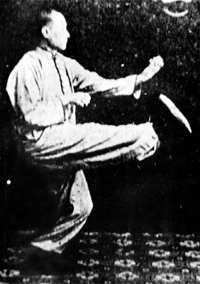
Eagle Claw is a style of Chinese martial arts known for its gripping techniques, system of joint locks, takedowns, and pressure point strikes, which is representative of Chinese grappling known as Chin Na. The style is normally attributed to the famous patriotic Song dynasty General Yue Fei. Popular legends states that he learned martial arts from a Wudang Monk named Zhou Tong and later created Eagle Claw to help his armies combat the invading armies of the Jin dynasty. It was passed down until the Ming dynasty. Thus, the style took on long range strikes and aerial jumps. During the Qing dynasty, the military instructor Liu Shi Jun became known as the modern progenitor of Eagle Claw and taught many students. His student Liu Cheng You later taught Chen Zizheng who was invited to teach the style in the prestigious Chin Woo Athletic Association during the Republican era. The style spread as Chin Woo opened sister schools in other provinces. Today, it is practiced around the world.

The Smiling, Proud Wanderer is a wuxia novel by Jin Yong. It was first serialised in Hong Kong in the newspaper Ming Pao from 20 April 1967 to 12 October 1969. The Chinese title of the novel, Xiao Ao Jiang Hu, literally means to live a carefree life in a mundane world of strife. Alternate English translations of the title include The Wandering Swordsman, Laughing in the Wind, The Peerless Gallant Errant, and The Proud and Gallant Wanderer. Another alternative title, State of Divinity, is used for some of the novel's adaptations.
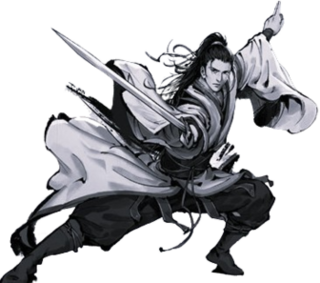
Zhang Wuji is the fictional protagonist of the wuxia novel The Heaven Sword and Dragon Saber by Jin Yong.

The Heaven Sword and Dragon Saber, also translated as The Sword and the Knife, is a wuxia novel by Jin Yong and the third part of the Condor Trilogy, preceded by The Legend of the Condor Heroes and The Return of the Condor Heroes. It was first serialised from 6 July 1961 to 2 September 1963 in the Hong Kong newspaper Ming Pao.
The Ming Cult is a fictional cult and martial arts school featured in the wuxia novel The Heaven Sword and Dragon Saber by Jin Yong, first published in serial form from 1961 to 1963. It is also briefly mentioned in The Legend of the Condor Heroes, another novel also by Jin Yong. It is loosely based on Manichaeism, an actual gnostic religion which originated in Persia in the 3rd century CE and later spread to other parts of the world, including China. The cult's headquarters is at Bright Peak in the Kunlun Mountains and it has several other bases spread throughout China. Its most powerful skills are the "Heaven and Earth Great Shift" and the "Martial Arts of the Holy Flame Tablets".
The Jiuyang Zhenjing, also known as the Nine Yang Manual, is a fictional martial arts manual in Jin Yong's Condor Trilogy. It was first introduced briefly at the end of the second novel The Return of the Condor Heroes. It plays a significant role in the third novel The Heaven Sword and Dragon Saber after Zhang Wuji discovers it and masters the skills in the book.
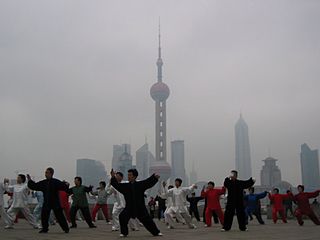
There are hundreds of different styles of Chinese martial arts, each with their own sets of techniques and ideas. The various movements in kung fu, most of which are imitations of the fighting styles of animals, are initiated from one to five basic foot positions: normal upright posture and the four stances called dragon, frog, horse riding, and snake.
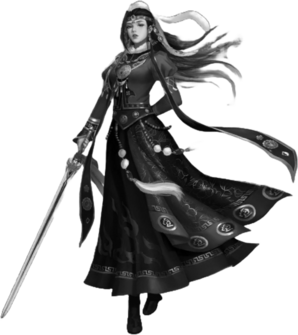
Zhao Min (趙敏), birth name Minmin Temür (敏敏特穆爾), formally Commanderial Princess Shaomin (紹敏郡主), is one of the two female lead characters in the wuxia novel The Heaven Sword and Dragon Saber by Jin Yong. Jin Yong describes her appearance as "naturally elegant, with a bright countenance".

Zhou Zhiruo is one of the two female lead characters in the wuxia novel The Heaven Sword and Dragon Saber by Jin Yong. Jin Yong describes Zhou Zhiruo's physical appearance as "beautiful, pure and free of worldly traits".
The Wudang School, sometimes also referred to as the Wu-Tang Clan, is a fictional martial arts school mentioned in several works of Chinese wuxia fiction. It is commonly featured as one of the leading orthodox schools in the wulin. It is named after the place it is based, the Wudang Mountains.
The Emei School is a fictional martial arts school mentioned in several works of wuxia fiction. It is commonly featured as one of the leading orthodox schools in the jianghu. It is named after the place where it is based, Mount Emei.
The Kunlun School is a mostly fictional martial arts school mentioned in several works of wuxia fiction. It is usually featured as a leading orthodox school in the jianghu / wulin. It is named after the place where it is based, the Kunlun Mountains in western China, near modern Qinghai and Xinjiang provinces. Due to its geographical location, it was hardly known to martial artists in the jianghu before its rise to prominence.
The Mount Hua Sect, also known as the Huashan Sect, is a fictional martial arts sect mentioned in several works of wuxia fiction. It is commonly featured as one of the leading orthodox sects in the wulin. It is named after the place where it is based, Mount Hua. The sect appears in three of Jin Yong's novels.

The Heaven Sword and Dragon Saber is a Chinese television series adapted from Louis Cha's novel of the same title. It is a final instalment of a television trilogy produced by Zhang Jizhong, preceded by The Legend of the Condor Heroes (2003) and The Return of the Condor Heroes (2006). Unlike the previous adaptations, this remake is the first to be primarily based on the third edition of the novel. The series was first broadcast on Wenzhou TV in China in October 2009.

Kung Fu Cult Master is a 1993 Hong Kong wuxia film adapted from Louis Cha's novel The Heaven Sword and Dragon Saber. Directed by Wong Jing, it featured fight choreography by Sammo Hung and starred Jet Li, Sharla Cheung, Chingmy Yau, and Gigi Lai in the lead roles.
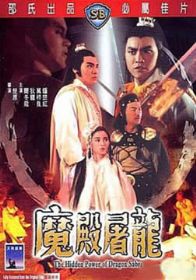
The Hidden Power of the Dragon Sabre is a 1984 Hong Kong wuxia film directed by Chor Yuen and produced by the Shaw Brothers Studio. The film is a spinoff of Louis Cha's novel The Heaven Sword and Dragon Saber.

Wudangquan is a class of Chinese martial arts. In contemporary China, Chinese martial arts styles are generally classified into two major groups: Wudang (Wutang), named after the Wudang Mountains; and Shaolin, named after the Shaolin Monastery. Whereas Shaolin includes many martial art styles, Wudangquan includes only a few arts that use the focused mind to control the body. This typically encompasses tai chi, xingyiquan and baguazhang, but must also include bajiquan and Wudang Sword. Although the name Wudang simply distinguishes the skills, theories and applications of the internal arts from those of the Shaolin styles, it misleadingly suggests these arts originated at the Wudang Mountains. The name Wudang comes from a popular Chinese legend that incorrectly purports the genesis of tai chi and Wudang Sword by an immortal, Taoist hermit named Zhang Sanfeng who lived in the monasteries of Wudang Mountain. Wudangquan is often used synonymously with Neijia, but Neijia is a broader term that also encompasses Qigong, which is not Wudangquan.

Heavenly Sword and Dragon Slaying Sabre is a 2019 Chinese wuxia television series adapted from the novel The Heaven Sword and Dragon Saber by Jin Yong. Originally published in newspapers from 1961 to 1963, the story has been revised twice; once in 1979 and the second in 2005. This remake is primarily based on the third edition of the novel and also being promoted as a rework to the 1994 adaptation. The series is the first adaptation to be released as a web series and was first broadcast on Tencent in China on February 27, 2019.